Zoom
Trash

Becoming a Critic Of Your Thinking. Learning the Art of Critical Thinking There is nothing more practical than sound thinking.
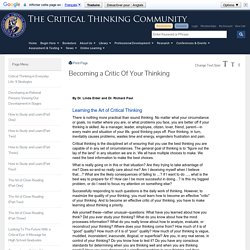
No matter what your circumstance or goals, no matter where you are, or what problems you face, you are better off if your thinking is skilled. As a manager, leader, employee, citizen, lover, friend, parent---in every realm and situation of your life, good thinking pays off. Poor thinking, in turn, inevitably causes problems, wastes time and energy, engenders frustration and pain.
Critical thinking is the disciplined art of ensuring that you use the best thinking you are capable of in any set of circumstances. What is really going on in this or that situation? Successfully responding to such questions is the daily work of thinking. Ask yourself these--rather unusual--questions: What have you learned about how you think? If you are like most, the only honest answers to these questions run along the lines of: “Well, I suppose I really don’t know much about my thinking or about thinking in general. 2. Transforming Midterm Evaluations into a Metacognitive Pause. Midterm evaluations often tip toward students’ (unexamined) likes and dislikes.
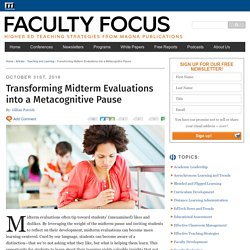
By leveraging the weight of the midterm pause and inviting students to reflect on their development, midterm evaluations can become more learning-centered. Cued by our language, students can become aware of a distinction—that we’re not asking what they like, but what is helping them learn. This opportunity for students to learn about their learning yields valuable insights that not only inform instructors about the effects of our methods, but also ground students in their own learning processes, deepening their confidence in and commitment to their development in the second half of the course.
Last semester, I taught a research-based contemporary poetry course with a steep learning curve—due to our rather difficult, graduate-level texts and students’ lack of prior experience. Repice observed that “This set of questions calls attention to the ways you are learning. Lee, Virgina S. Nilson, Linda B. (2016.) Classroom Cognitive and Metacognitive Strategies for Teachers Revised SR 09.08.10. Cognitive Strategies. A cognitive strategy is a mental process or procedure for accomplishing a particular cognitive goal.
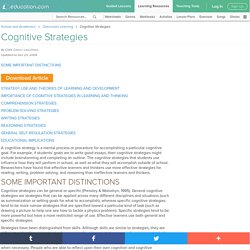
Teaching Concepts: Cognitive Strategy. Goal Setting | Motivation | Cognitive Strategy | Cooperative Learning | Assessment.

Response to Intervention. Solving an advanced math problem independently requires the coordination of a number of complex skills.
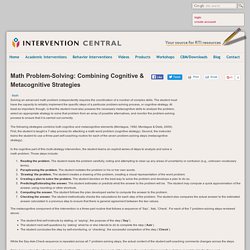
The student must have the capacity to reliably implement the specific steps of a particular problem-solving process, or cognitive strategy. Wentworth Institute of Technology. Promoting Student Metacognition. 1219 6024 1 PB. Metacognition and confidence: comparing math to other academic subjects. 31958 111388 1 PB. 10. Module 4: Metacognitive Strategies for Reading and Writing. Module Introduction No matter what degree you are pursuing or what career you plan to go into; reading and writing skills are essential.

Think of just about every job ad you see, usually they say that "Excellent communication skills" are a highly desired trait. What exactly are "excellent communication skills? " Well, at their core, it is the ability to clearly express your thoughts and ideas both verbally and in writing. Another vital skill that employers need from their employees today is the ability to research, review and draw conclusions from data, reports and other informative sources. In this module we will investigate and try out some methods for active reading and conscious writing that you may not have come into contact with before. METACOGNITION. METACOGNITION: Study Strategies, Monitoring, and Motivation By William Peirce © 2003 A greatly expanded text version of a workshop presented November 17, 2004, at's Community College Outline II.
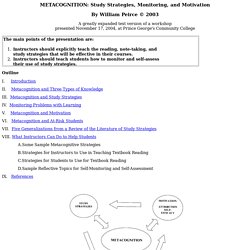
Metacognition and Three Types of Knowledge III. IV. V. VI. Metacognative Strategies. Metacognitive Strategies Introduction This site provides a detailed description of metacognitive strategies.
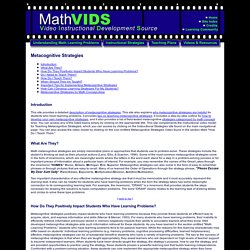
This site also explains why metacognitive strategies are helpful for students who have learning problems, it provides tips on teaching metacognitive strategies, it includes a step-by-step outline for how to develop your own metacognitive strategies, and it also provides a list of field-tested metacognitive strategies categorized by math concept area. You can access any of the listed topics simply by clicking on the appropriate title. This site complements the instructional video model for Teaching Metacognitive Strategies, which you can access by clicking on the Instructional Strategies site found on the main navigational page.
Response to Intervention. Metacognition And Learning: Strategies For Instructional Design. Do you know how to learn?
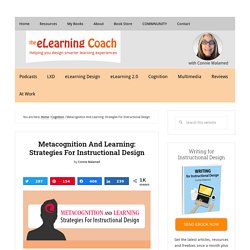
Many people don’t. Specifically, they don’t know how to look inward to examine how they learn and to judge which methods are effective. That’s where metacognitive strategies come in. They are techniques that help people become more successful learners. Response to Intervention. Metacognition ELI. Stylus/Stylus Publishing - Using Reflection and Metacognition to Improve Student Learning: Across the Disciplines, Across the Academy. Table of Contents: AcknowledgmentsForeword—James Rhem1) Reflective Pedagogies and the Metacognitive Turn in College Teaching—Naomi Silver2) Make Exams Worth More than the Grade: Using Exam Wrappers to Promote Metacognition—Marsha C.
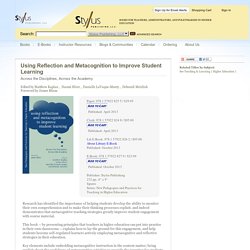
Lovett3) Improving Critical-Thinking Skills in Introductory Biology Through Quality Practice and Metacognition—Paula P. Lemons, Julie A. Reynolds, Amanda J. Curtin-Soydan, and Ahrash N. EJ1029627. Schoenfeld metacognition. Exam Wrappers. All too often, when students receive back a graded exam, they focus on a single feature – the score they earned. While this focus on “the grade” is understandable, it can lead students to miss out on several learning opportunities that such assessment can provide: identifying their own individual areas of strength and weakness to guide further study;reflecting on the adequacy of their preparation time and the appropriateness of their study strategies; andcharacterizing the nature of their errors to find any recurring patterns that could be addressed.
So, to encourage students to process their graded exams more deeply, several faculty members across the university have devised exam wrappers, short handouts that students complete when an exam is turned back to them. These exam wrappers direct students to review their performance (and the instructor’s feedback) with an eye toward adapting their future learning. Metacognition-ELI. Teaching Metacognition. This webpage is a summary, written by Carol Ormand, of Marsha Lovett's presentation at the 2008 Educause Learning Initiative conference. Dr. Lovett's slides and a podcast of her presentation can be accessed via the conference website. CAPABLE: Calculus Acquisition through Problem and Activity Based Learning.
TCM 2015 - Encouraging Metacognition in the Math Classroom. Getting Metacognition Out of the Closet. Metacognition is not a common word. In fact, every time I typed "metacognition" or "metacognitive" in this article it was automatically underlined in red. Microsoft doesn't consider it a word, a sad state of affairs for such an important term. Teaching Metacognative Strategies. Teaching Excellence in Adult Literacy (TEAL) Metacognition is one’s ability to use prior knowledge to plan a strategy for approaching a learning task, take necessary steps to problem solve, reflect on and evaluate results, and modify one’s approach as needed. It helps learners choose the right cognitive tool for the task and plays a critical role in successful learning.